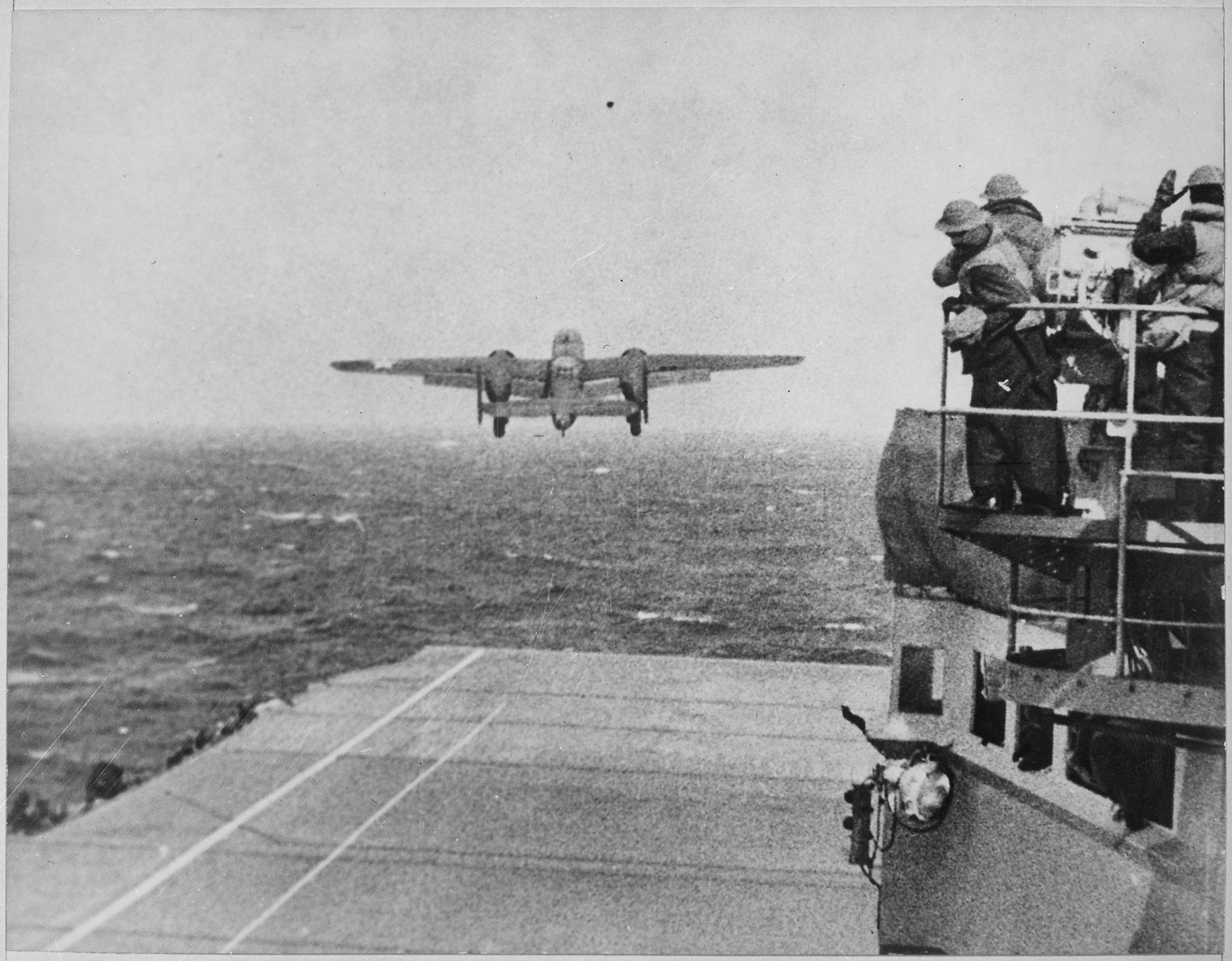An Army B-25 Takes Off for the First U.S. Air Raid on Japan
4/1942
Add to Favorites:
Add all page(s) of this document to activity:

The original caption for this photograph reads: Take off from the deck of the USS HORNET of an Army B-25 on its way to take part in first U.S. air raid on Japan. Doolittle Raid, April 1942.
Four months after Japan’s surprise attack at Pearl Harbor, Hawaii, the aircraft carrier USS Hornet sailed under the Golden Gate Bridge and out of San Francisco Bay into the Pacific Ocean on a secret mission. The Hornet carried 16 specially equipped B-25 bombers and a crew of 200. The bombers were to take off from the deck of the Hornet, which bombers had never done, and drop four specially built bombs on targets in Japan. Next, they would fly on to China, where they would be met by friendly Chinese after landing at prearranged locations.
The idea for striking the Japanese homeland came from President Franklin D. Roosevelt himself, who felt that the nation needed a morale booster after the Pearl Harbor attack on December 7, 1941.
This particular air strike on the Japanese homeland was devised by Lt. Col. James H. Doolittle of the Army Air Forces and has become known as the "Doolittle Raid." Doolittle would pilot the first plane, and the other 15 would take off from the deck of the Hornet as soon as the one ahead of it was in the air.
However, not everything went according to plan. A Japanese portal craft spotted the USS Hornet and forced the raid to start 10 hours earlier and 200 miles farther from Japan. All 16 planes were able to take off from the deck of the Hornet and deliver their bombs to the designated targets, but because they had taken off about 200 miles farther from Japan than planned, they would not have enough fuel to make it to where they were supposed to land in China. In the end, 15 of the planes crash landed in China or in the ocean.
The raid, however, proved to be the morale-booster that Roosevelt was looking for. Although the damage in Tokyo and elsewhere was not significant, it demonstrated to the Japanese people that the Americans could reach their homeland – and might return again.
Four months after Japan’s surprise attack at Pearl Harbor, Hawaii, the aircraft carrier USS Hornet sailed under the Golden Gate Bridge and out of San Francisco Bay into the Pacific Ocean on a secret mission. The Hornet carried 16 specially equipped B-25 bombers and a crew of 200. The bombers were to take off from the deck of the Hornet, which bombers had never done, and drop four specially built bombs on targets in Japan. Next, they would fly on to China, where they would be met by friendly Chinese after landing at prearranged locations.
The idea for striking the Japanese homeland came from President Franklin D. Roosevelt himself, who felt that the nation needed a morale booster after the Pearl Harbor attack on December 7, 1941.
This particular air strike on the Japanese homeland was devised by Lt. Col. James H. Doolittle of the Army Air Forces and has become known as the "Doolittle Raid." Doolittle would pilot the first plane, and the other 15 would take off from the deck of the Hornet as soon as the one ahead of it was in the air.
However, not everything went according to plan. A Japanese portal craft spotted the USS Hornet and forced the raid to start 10 hours earlier and 200 miles farther from Japan. All 16 planes were able to take off from the deck of the Hornet and deliver their bombs to the designated targets, but because they had taken off about 200 miles farther from Japan than planned, they would not have enough fuel to make it to where they were supposed to land in China. In the end, 15 of the planes crash landed in China or in the ocean.
The raid, however, proved to be the morale-booster that Roosevelt was looking for. Although the damage in Tokyo and elsewhere was not significant, it demonstrated to the Japanese people that the Americans could reach their homeland – and might return again.
This primary source comes from the General Records of the Department of the Navy.
National Archives Identifier: 520603
Full Citation: Photograph 80-G-41196; Take off from the deck of the USS HORNET of an Army B-25 on its way to take part in first U.S. air raid on Japan. Doolittle Raid; 4/1942; General Photographic Files, 1943 - 1968; General Records of the Department of the Navy, Record Group 80; National Archives at College Park, College Park, MD. [Online Version, https://docsteach.org/documents/document/take-off-uss-hornet, April 20, 2024]Rights: Public Domain, Free of Known Copyright Restrictions. Learn more on our privacy and legal page.



